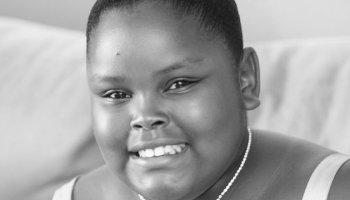
Usually, I use this column to answer questions. Today, I will discuss the death of Jahi McMath and the new legal issues stemming from Jahi having been pronounced dead in California on December 13, 2013 and again on June 22, 2018 in New Jersey.
For anyone unfamiliar with Jahi’s tragic story, she was a beautiful, radiant, 12-year-old girl who went to Children’s Hospital Oakland to undergo several procedures, including a tonsillectomy, an adenoidectomy, and a revision to her soft palate to address a condition known as apnea, which causes trouble with breathing. Jahi’s surgery, on December 9, 2013, was seemingly without incident, and she was taken to the ICU for post-surgical recovery where her mother was present to comfort her.
At first, there was no sign of danger or complication. Jahi was given a popsicle, as many post-surgical pediatric patients are, to help provide hydration and to reduce any swelling and pain through the cold ice of the popsicle. Shortly after Jahi was in recovery, where she was communicating with her mother, Jahi started bleeding from her mouth. Her mother, Nailah, brought this to the attention of the nurses in attendance, and the nurses said this was normal.
They provided Nailah with a towel to help absorb the blood. Jahi continued bleeding, and the bleeding increased. Again, Nailah asked the nurses to have a physician come see Jahi, but again she was told that this was normal and was given a basin to help collect the blood which was now coming more rapidly from Jahi’s mouth. Jahi was in fear and communicated to her mother that she was scared and that she was worried she might never wake up. Nailah comforted her daughter and assured her everything would be alright.
As the bleeding continued and increased, Nailah was given a suction tube to suction blood from the corner of Jahi’s mouth. Again, no doctor was summoned. Nailah, afraid for her daughter, called her own mother, Sandra Chatman, a wound care nurse, to come and see Jahi to determine if this was in fact “normal” as Nailah had been told. As soon as Sandra appeared, she saw Jahi’s critical state and demanded a doctor be summoned immediately. Sandra had to make several requests, and, as a doctor was finally summoned, Jahi’s heart stopped because of the massive blood loss. The doctors tried to revive Jahi and pump blood products into her to try to replace the volume of blood Jahi had lost. After almost an hour, the doctors gave up and were about to pronounce Jahi dead when Jahi’s heart started beating.
Because of Jahi’s severe blood loss and heart attack, she was deprived of oxygen to her brain and suffered a catastrophic anoxic brain injury, which led to swelling of her brain. The doctors at Children’s Hospital then told Nailah that Jahi had irreversible brain damage. Immediately, Nailah was hounded by nurses trying to get her to sign a release so that Jahi’s organs could be harvested for transplant. Nurses even followed Nailah into the chapel as she tried to pray for her daughter’s survival.
On December 12, 2013, Jahi was declared brain-dead. Under California law, brain death occurs when there is a total and irreversible cessation of all neurological activity, including the brain stem. Nailah refused requests to remove her daughter from life support as she “knew Jahi was not dead.” Nailah stated she could feel it in her heart and in her soul. The doctors then said they would remove Jahi from the ventilator despite Nailah’s protests. Nailah refused. Soon after, her brother, Omari Sealey, called me at 10:30 p.m. saying that the hospital was going to unplug Jahi at 8:30 a.m. the following morning. I knew nothing about the very public nature of Jahi’s case and turned on the television to see Omari on the phone to me. I agreed to write a cease and desist letter demanding that the hospital stop their plans to kill Jahi. I agreed to represent the family, pro bono (for free), and Nialah asked me to put it in writing because they did not have money to pay for a lawyer. I did as she asked and threw myself into a furious legal battle, one that I will never regret.
We succeeded in establishing, for the first time, that, contrary to the doctor’s position, parents do have a say in the end of their child’s life following a brain-death diagnosis. Through a series of injunctions, we kept Children’s Hospital from killing Jahi through Christmas and into early January. A brain-death exam, a primitive reflex-based test, was done by a court-ordered expert, Dr. Paul Fischer, which I observed. Jahi, in her weakened state was ruled brain-dead. Nailah refused to allow her daughter to be killed, and Jahi’s execution date was set only to be suspended, at the last minute, by a continued injunction based on the filing of an appeal of the brain-death ruling from the Alameda County Superior Court.
Finally, in late December, a deal was brokered to remove Jahi from the hospital. The hospital demanded that the coroner take the body, so a disposition permit allowing Nailah to take Jahi’s being was required. To obtain a disposition permit, a death certificate was required. Despite the acting Public Health Officer’s initial refusal to issue a death certificate, as Jahi was still on life support, we pressed forward and, under protest, obtained a death certificate.
While I was fighting the legal battle, I, along with a number of good-natured people of faith throughout the country, sought a facility to provide Jahi with the care she needed: antibiotics to fight off the infections she was allowed to develop at Children’s Hospital, a tracheostomy to put in a breathing tube, and placement of a feeding tube. Every time we would find a facility, Children’s Hospital spoke to them, and the facility would withdraw their willingness to accept Jahi. This was maddening, as the clock was ticking down to Jahi’s death, and I was running out of options.
Finally, we located a Catholic Hospital in New Jersey, which agreed to accept Jahi. We kept the identity and location of this facility secret from Children’s Hospital so there could be no chance that they might persuade the facility not to accept Jahi. We were in a race against time, as Jahi was dying from the lack of care at Children’s Hospital. The hospital had denied Jahi any nutrition for over 23 days. Under the cover of darkness, and under the noses of the flange of television crews (who were watching the Packers/49rs game), we spirited Jahi off to a private airfield in Oakland, and her mother accompanied her on a life flight jet to New Jersey. Jahi almost died in route.
The hospital’s retained experts and physicians swore in declarations that no care or intervention could forestall Jahi’s death, which was imminent, within hours or days. They were wrong. Jahi received intensive intervention in New Jersey and was ultimately discharged to a home environment where she lived with her mother, stepfather and sister for over four years. Over those four years, Jahi began communicating in response to her mother’s voice. She could move her fingers, hands and feet in response to requests by her mother and eventually could signal yes or no.
This was all videotaped, and a leading pediatric neurologist, Dr. Alan Shewmon, who believes in the legal and medical concept of brain death, published a peer-reviewed article in the Journal of Child Neurology, entitled “False-Positive Diagnosis of Brian Death,” which concluded Jahi was not brain-dead in 2018, although she may have appeared to have been based on testing in 2013. Additional peer-reviewed articles were published by experts, including Dr. Calixto Machado, a neurologist seen as one of the premier international brain-death experts, which showed that electroencephalographic testing (EEG) showed that Jahi had brain-wave activity, and MRIs of the brain showed that it was, while severely damaged, still intact. In a case of total brain death, the brain liquifies and is absorbed into the body. This did not happen in Jahi’s case.
Legal proceedings in both the state and federal courts were ongoing throughout this time to prove Jahi was alive. In a medical negligence case, judges repeatedly ruled that the facts created a triable issue of fact that Jahi was alive. As the brain-death statute required that there needed to be total and irreversible cessation of all neurological activity, the judges ruled that there was evidence which should be presented to a jury for them to decide if Jahi was alive or not. Sadly, as that case was being prepared, Jahi died.
The death of Jahi has not ended the controversies surrounding brain death. An international debate is ongoing in the medical and scientific communities about whether brain death can be determined using antiquated testing while a patient is suffering from acute trauma. Indeed, I have personally helped other families deal with the brain-death diagnosis, including the family of Anahita Meshkin, who was diagnosed brain-dead in the East Bay, for whom we obtained an injunction and an independent medical evaluation showing she was not brain-dead. She would have, in fact, been murdered.
There are forces that desperately want to defend the brain-death diagnosis: health insurance companies, who do not want to pay for treatment, the multi-million-dollar transplant industry (which does save lives), and doctors who think they know what the best uses of medical resources are. This is a debate which needs to be done out in the open as we age and our medical resources will be taxed. Doctors should not be able to use the brain-death diagnosis to do what they think is best. This strips the rights of the patients and families. What next, abort children with severe birth defects who are destined to die after absorbing tremendous medical resources? Terminate the elderly suffering from severe brain damage from Alzheimer’s because they are so damaged they cannot care for themselves, know what is happening, who they are, or otherwise have a “meaningful existence” or “quality of life”?
What I know is that Jahi was alive and that she and her mother, who is a hero of almost biblical proportions, living a life of persecution and sacrifice, like Job, had a real relationship of love and commination.
Jahi died on June 22, 2018, as evidenced by her New Jersey Death Certificate. Jahi did not die of brain death but rather bleeding caused by liver failure. The legal debate now continues over which death certificate and which date of death controls. The California Death Certificate was never completed or signed, as required by law, by any attending physician. The New Jersey Death Certificate is full, complete and final, being duly executed after an autopsy. What is clear is that, despite Jahi’s death, her name and her cause lives on. She has changed the way the world looks at brain death, has stimulated widespread debate within the medical and scientific communities, and has touched the hearts of millions. Like her mother, I regret not one moment of this fight for this beautiful girl.
Finally, I wish to share the words of her mother: “Don’t be in a hurry to unplug your people. Give them and God a chance to heal”.










